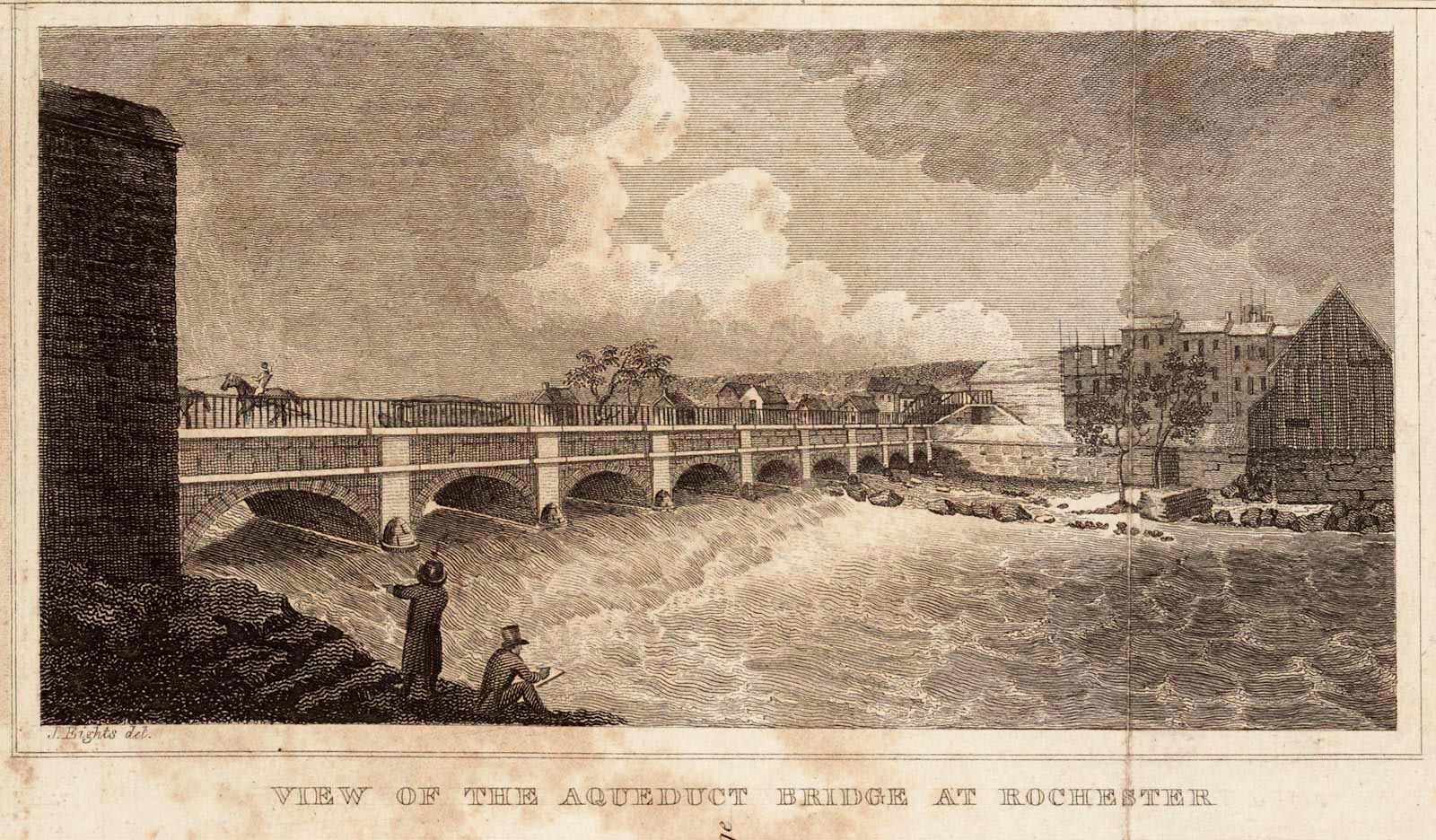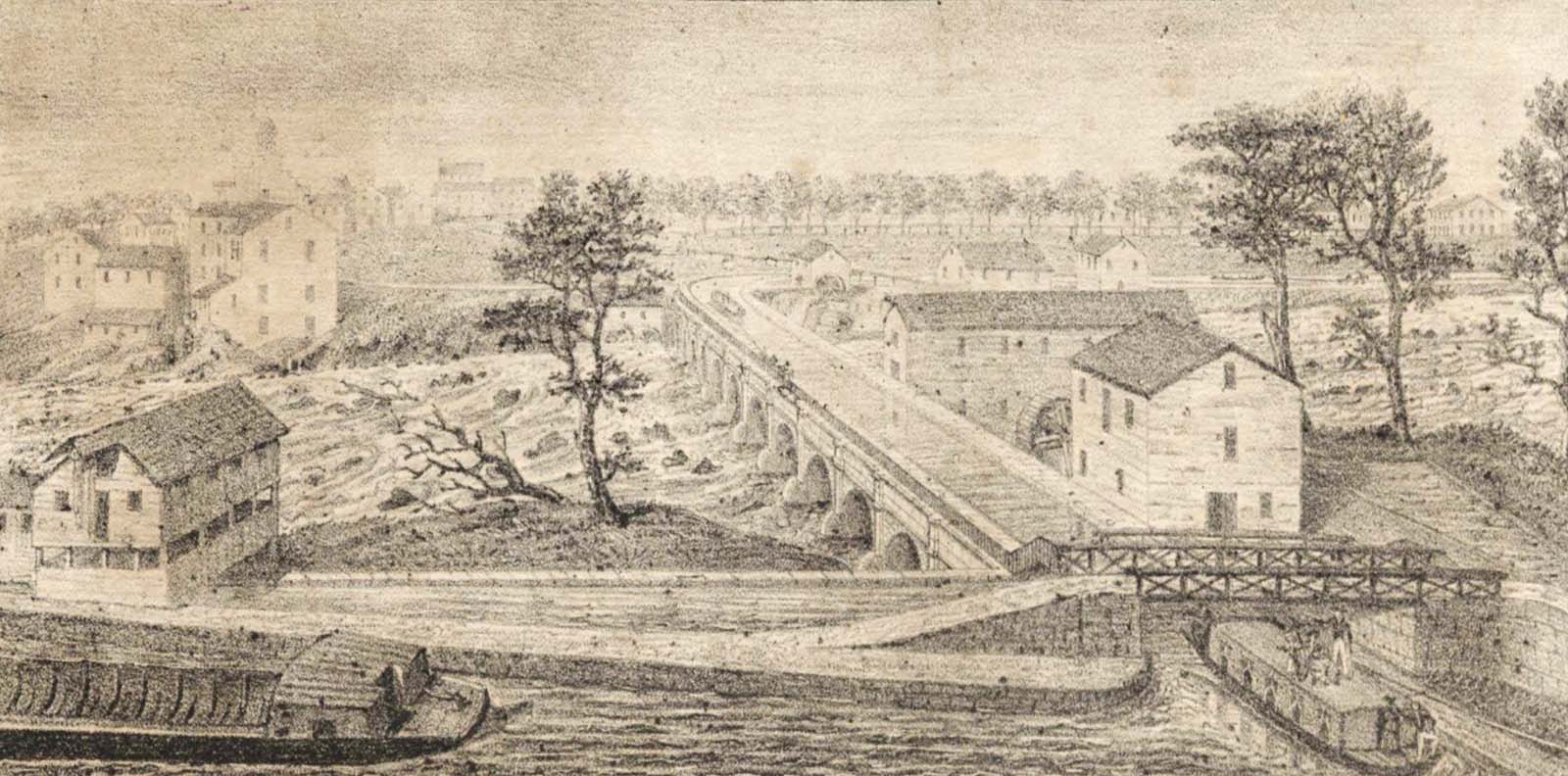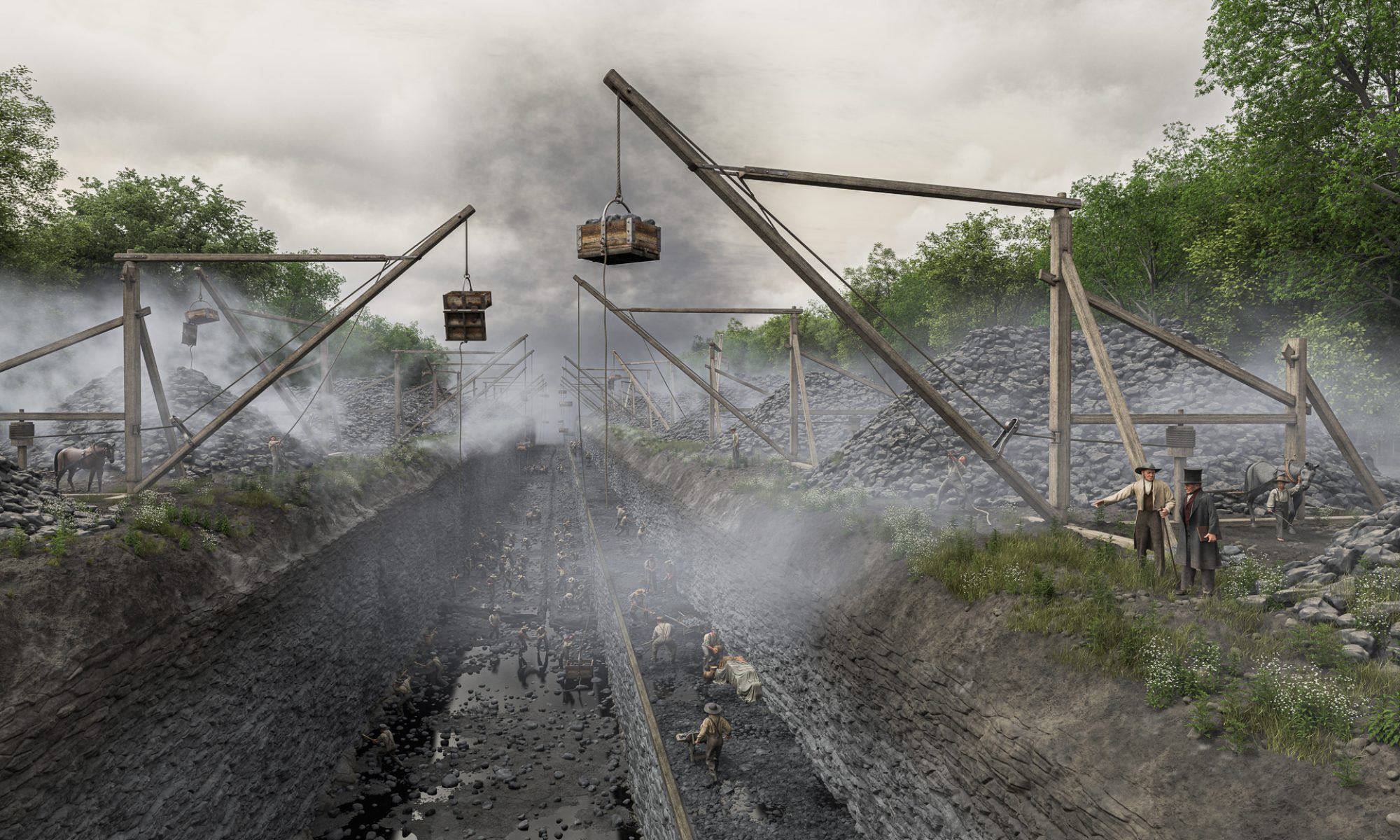
The great aqueduct over the Genesee River at Rochester was built over fifteen months, from July 1822 to September 1823.
Actual construction, however, took about eight months. Though work elsewhere along the canal line began each year in early spring, the aqueduct builders in Rochester waited till July, when the level of the river dropped. Most of its water was then diverted into the millraces on the east and west banks, allowing access to the rocky riverbed.
The contractors — Alfred Hovey, Abel Wethey, and a handful of others — may have been under pressure to finish the job quickly. The state’s canal commissioners hoped to open the entire canal from Albany to Buffalo by the end of 1823. They did not know that difficulties further west at Lockport would delay everything for another two years. In 1822, they may have assumed that Rochester would be the bottleneck.
Already an entire year had been wasted. Hovey and Wethey’s contract represented the second attempt to cross the river. The first, commenced the previous year by William Brittin, had failed disastrously. Ill-prepared and underfinanced, Brittin had managed to erect only a culvert and the eastern abutment by the time the river rose that fall. During the ensuing winter it carried off the abutment, leaving behind a few straggling anchor bolts bent over by the force of the current. That December, Brittin died.
The partners who picked up the contract spent much of the winter of 1822 searching for a convenient source of suitable building material — stone that was durable, easy to work, and that could be quarried in blocks large enough to withstand the force of the river’s annual floods. They found this durable material, or so they thought, at the bottom of the Genesee River gorge: a layer of red Medina sandstone.
Most of the stone used to build the aqueduct would come from here. After being cut from the quarry, the large red blocks, from two to five feet thick and weighing several tons apiece, were somehow hauled to the brink of the gorge — a near-vertical ascent of almost 200 feet. Or perhaps they were floated downstream to Hanford’s Landing, where skids had been built to convey heavy items between the top of the gorge and the water’s edge. Either way, the blocks then would have been hauled by ox-drawn sled to the aqueduct site three miles away.
In all, more than 13,500 cubic yards of rock would be used to build the aqueduct, enough to fill a football field with a stack of stone blocks six feet high. As the stones slowly piled up on the east and west banks of the river, workers used black powder to blast away the shelves of the Upper Falls that were in the way.
Much of the quarrying and blasting — the most difficult and dangerous work — was done by convicted criminals from the new state prison at Auburn.
Stone construction is an ancient art; the methods used by the aqueduct builders would have hardly changed for thousands of years. First, the rough blocks were cut and dressed by skilled masons, who took particular care to fashion the wedge-shaped voussoirs to precisely fit into each arch. Then the heavy blocks were transported up to four hundred feet out over the riverbed and delicately lowered into place. Tolerances were measured in fractions of an inch. Aside from the animal teams used to haul the stones to the site, the work was entirely powered by human effort.
They worked quickly, setting the abutments and piers firmly into the rocky bed of the river and erecting the nine main arches, each of which took only a few days to complete. By the end of 1822 all of the arches and the walls between them were finished.
The water table, parapets, pilasters, and coping were assembled from enormous slabs of gray Cayuga County limestone, delivered by way of the partially completed canal from quarries sixty miles away. The aqueduct was finished by September 1823. It opened amid a shower of toasts the following month.
Erie Canal engineer David Bates described the completed work in the Rochester Telegraph:
“This stupendous fabric, which forms a prominent link in the great chain of our inland communication, is built on one of the rifts which compose a part of the extensive falls of the Genesee river.
“The Aqueduct, from the eastern extremity of its parapet walls to its western termination, is 804 feet long, and is built on eleven arches; one [on the east side] of twenty-six feet chord, under which passes the water necessary for a number of important flouring mills, &c., nine of fifty feet chord, and one on the west side of the river of thirty feet chord, under which passes water for a number of flouring mills and other hydraulic establishments. . . .
“The structure is founded on solid rock, in which nitches [sic] were cut to found the piers, which are thirty-six feet long and ten feet wide, including at each end a pedestal and dome, out of which rises a pilaster. The height of the piers is about four and an half feet; the rise of the arch eleven feet; its thickness at the foot three feet; at the apex, two and an half feet. The parapet walls or sides of the trunk, are five and an half feet high, including the coping, which is so constructed as to form a capital to tile whole trunk. The whole of this immense building is of cut stone; many of them, particularly the piers, of very great size. . . .
“On the north wall, which is of sufficient thickness for the towing path, is an elegant iron railing; and at the west end the whole is terminated by a highway and towing-path bridge of the most solid and elegant workmanship.”1
Alas, the aqueduct’s flaws would soon become apparent. They were several, all serious.
First, integrating the existing channel of Elisha Johnson’s north-south millrace into the east-west alignment of the canal had resulted in a ninety-degree turn at the aqueduct’s eastern end that would snarl traffic and prove hazardous for large boats.
Second, the seventeen-foot width of the aqueduct waterway meant that canal traffic across the river would be one-way. Eastbound boats would have to wait for westbound boats, and vice-versa. Rochester was a busy canal port. Basins near both ends of the aqueduct would have been crowded with passenger and freight traffic. As much as any other feature of the canal, the aqueduct’s narrow width would create endless bottlenecks and fistfights among canal-boat bullies.
The final insult: Not only was the aqueduct the wrong size and possibly built in the wrong place, it leaked. This may have been partly due to its rapid and probably substandard construction. But the main culprit was the red Medina sandstone of which it was built, a poor choice of building material that turned out to be porous. The aqueduct began to crumble as Rochester’s yearly freeze-thaw cycle broke up the stones and the water lime that filled the gaps between them.
By the 1830s engineers began to draw up contingency plans in case the aqueduct failed completely. Its replacement, finished in 1842, stands to this day: a testament to professional engineering, quality workmanship, and the tough limestone of which it is made.

Rebuilding the aqueduct
You may have guessed by now that the construction of the first Rochester aqueduct will be the subject of my next landscape.
All of my images are based as much as possible on original research, but I realized early on that this one would be in a league of its own. There were many stories to follow: The construction of the aqueduct, the founding and early growth of Rochester, and the development of the flour milling industry, to name just a few. Following these stories took a few years and involved several trips across New York state to visit libraries, historical societies, and archives. Many hours were spent online going through newspapers, property deeds, state prison records, and period textbooks and treatises on carpentry, masonry construction, and civil engineering.
I’m planning to post more frequently as work on the landscape continues. Brief historical narratives will fill out the broad overview given here and will alternate with updates on the image itself.
If you haven’t already, please go back and read “There for the Taking,” “On the Brink,” and “Over the River.” These establish some historical context and set the stage. If you like, you can use the form on this website’s home page to subscribe to future posts.
- “The Aqueduct,” The (Rochester, New York) Telegraph, 14 October 1823, p. 2, col. 3; image copy, NYS Historic Newspapers (https://nyshistoricnewspapers.org/?a=d&d=rot18231014-01.1.2&e=——-en-20–1–txt-txIN———- : accessed 26 August 2024). ↩︎


Wonderfully detailed description. I am in awe of the thoroughness of your research.
Thank you!
Looking forward to your completion of the rendition of the Rochester aqueduct !
Hi Mr Boerner, I have become a fan of your research and your landscapes. I just had one of yours framed. Its the one of the Montezuma slackwater crossing. It’s in a gilded antique frame! I’ve walked the enlarged Erie (the canal’s second iteration from Lockport almost to Rome and will continue on next spring). The village of Montezuma, the 1850s aqueduct, and the former junction of the Erie and the Cayuga/Seneca Canal in that village haunt me. Do you, or anyone, know much about the vanished hamlet of Meadville (also called Lockpit). It was on western edge of the swamp between Clyde and the Richmond Aqueduct? Thanks for all your cool work. Janus Mary Jones.
Thank you for the kind words. I’m impressed that you have walked so much of the enlarged Erie — what a good idea. I’m not familiar with Meadville, but have found it on some old maps. It was in the town of Galen, just west of the Savannah town line (and on the fringe of the Cayuga Marsh, as you said). Why are you interested in it? (If I may ask.)
Meadville, also called Lockpit, was on Lockpit Road. It had a lock, a grocery, a boardinghouse and was even the sight of a murder. I know I walked through it, but as there’s nothing left, I can’t be sure of its exact location on the road. Lockpit Cemetery is still there north of the site of the former hamlet. I walked the enlarged Erie as it followed present day power lines through fields and woods until it met Lockpit Rd, then canal ran alongside the road and into what’s now muckland, crossing Armitage Rd into Seneca County. Enlarged Erie (and me) continued further through the marshy reeds, through a campground to May’s Point. Then, alongside vanishing and overgrown Towpath Road where I excitedly and finally reached the western edge of the great Richmond Aqueduct. I am fascinated by places, like Meadville, that used to be something but now there’s nothing there.